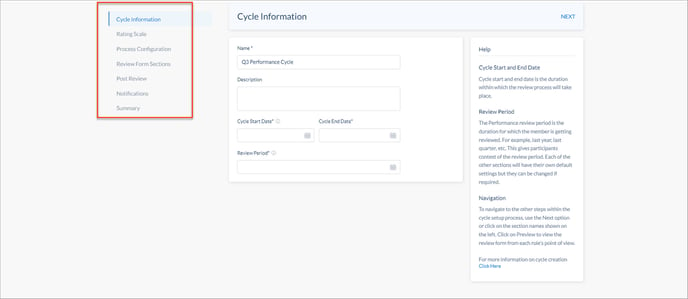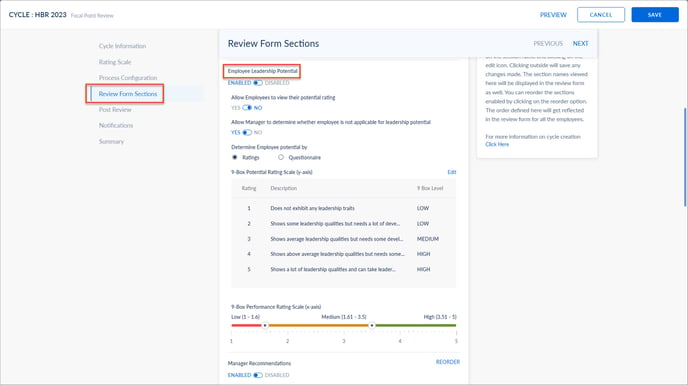Create performance review cycle
Tutorial ![]()
Creating a performance review cycle is crucial for evaluating and improving employee performance, aligning individual and organizational goals, and fostering a culture of communication, development, and accountability within the organization.
Based on their organization’s requirements, HR/admins can create and configure the workflows in the performance review cycle. Learn more in Performance user guide for admins.
Navigate to Performance > Cycles.
- Click CREATE, type the cycle name, and select the cycle type.
Three types of performance cycles are available: Focal Point Review, Hire Date Based Review, and Work Anniversary Review.
Follow steps to create a performance cycle:

Note: In the hire date based and work anniversary reviews, employees are automatically added to the review cycle based on their hire date.
3. In the Rating Scale step, select the rating type as required: Numeric Rating or Verbal Rating. You can configure the Verbal Rating under ADVANCED SETTINGS. Learn more in Glossary in Performance.
In the ADVANCED SETTINGS, perform the following actions as required:
- Show the rating scale to the employees in their review form.
- Change the name of the rating scale (for example, to evaluation scale, performance scale, assessment scale, or grading scale).
- Include Not Applicable (N/A) as a rating option in the rating scale.
- Round off the average rating.
Note: If you enable Round off the average rating, the final rating on the review form is rounded off to the nearest whole number. For example, if an employee's average rating is 3.3, it gets rounded off to 3.
- Add a grading scale, configure it, and click NEXT.
Note: In the grading scale, if you add the
- Correct minimum and immediate next maximum grades, the rating appears as grades in the performance review form.
- Incorrect minimum and maximum grades, the rating appears as Out of range in the performance review form.
Note: Employees and managers cannot see the actual calculation of the grading scale. It is visible only to the admins.
4. In the Process Configuration step, set up participants, timelines, and the review process flow in the performance review cycle.
- Perform the following actions:
- Allow employees to self-review and set the start and end dates.
- Enable rollback employee reviews by HR or both HR and managers.
- Allow reviewers to begin their reviews before employees submit their self-reviews.
- Set the manager’s review end date.
- Control the visibility of the manager's review immediately after submission.
- Decide who controls the visibility of reviews.
Note: If review visibility is set to both HR and managers, managers receive weekly reminders starting from the first Monday after the review is submitted. These reminders continue until the cycle end date.
-
- Restrict access to the review form for both employees and managers after the review end date.
Notes:
- Employees and managers must submit their reviews before their review end date. They cannot access the review form after the end date.
- The restriction feature applies only to focal reviews because they focus on performance and development. It does not apply to hire date–based or work anniversary reviews, as these relate to onboarding and employee experience, not performance.
-
You can manually extend the review end date to:
- Allow employees and managers to access the review form.
- Allow managers to delegate their reviews (if Delegate Review is enabled).
- Allow managers and yourself to roll back reviews (if Rollback Review is enabled).
- Send daily reminders to participants (if reminders are enabled).
-
- Enable skip-level manager capabilities in the review process.
- Skip-level reviewers can either:
- Approve review: Approve or rollback the manager’s review.
- Edit manager review: Edit and approve the manager’s ratings and comments.
- Skip-level reviewers can either:
- Enable skip-level manager capabilities in the review process.
- In ADVANCED SETTINGS, you can:
- Decide who can assign or recall templates.
- Set how templates are shared.
- Automatic: Employees view the template immediately after being added to the cycle.
- Manual: Templates are assigned and shared manually.
-
- Decide who can share the template if manual sharing is selected.
- Invite additional reviewers if employees work with multiple teams.
- Decide who can invite additional reviewers.
- Allow employees to view additional reviewers' comments.
Note: Additional reviewers can only comment on employee performance.
-
- Allow managers to view their direct reports' self-reviews.
- Allow additional reviewers to view both employee and manager reviews.
- Decide what ratings employees can view (overall, section, and subsection ratings) when the manager shares the review.
- Decide if managers can delegate their reviews.
- Click NEXT.

5. In the Review Form Sections step, add sections, configure them, and reorder them, which reflects in the review form.
Click REORDER, drag the Six Dot ![]() Icon to reorder the sections, and click SAVE.
Icon to reorder the sections, and click SAVE.
Note: Enable the sections to reorder them.
If required, rename the following sections:
Hover over the sections and click the Edit ![]() Icon to rename them.
Icon to rename them.
-
- Employee overall remarks
- Manager overall remarks
- HR overall remarks
- Employee Leadership Potential
- Review Notes
- Development Plans
- Training Recommendations
- One on One meetings
- HR Recommendations
- In the Review Form Sections, perform the following actions:
- Enable/disable manager overall remarks with their ratings and comments.
- Enable/disable employees’ overall remarks with their ratings and comments.
- Enable/disable HR overall remarks.
Note: HR/admins can only comment on the employees’ performance.
-
- Enable/disable employee leadership potential.
If you enable leadership potential, perform the following actions:
-
-
- Allow employees to view their potential rating.
- Allow the manager to determine whether the employee is not applicable to leadership potential.
- Determine employee potential by ratings or questionnaires as required.
- Edit/add potential and performance ratings/questionnaire for the 9-box grid.
-
Engagedly offers you pre-defined questions created by industry experts. Each question has a weightage.
The 9-box grid displays the employee’s and manager’s ratings in the review form.
Note: The 9-box rating is available for the focal point and work anniversary reviews.

-
- Enable/disable manager recommendations.
The manager recommendation questions are visible only to the managers on the review form.
-
- Allow Employees to view Manager recommendations.
- Enable/disable review notes, development plans, training recommendations, one-on-one meetings, and HR recommendations.
- Decide who can add training recommendations.
Add customizable sections with various question types to gather employees’ feedback for their performance assessment.
a. In the Review Form Sections, scroll down to the bottom, and click + ADD SECTION.
b. Type the section name and click outside the box to save it.
c. Select who can respond to the questions.
d. Enable Response mandatory if required and click + Add question.

e. Type a question, select the question type, and click SAVE.
There are various question types: Text, list, single selection, multiple selection, and star rating. You must provide options for list, single selection, and multiple selection question types.
After adding a question to the section, edit or delete it if required.
After adding a section, disable or remove it if required.
Note:
- If you disable a section, you can enable it again at any time, with all questions retained.
- If you remove a section, it removes all questions associated with it.
- Click NEXT.
6. In the Post Review step, perform the following actions:
- Enable/disable the sign-off.
Note: If you enable the sign-off, by default, employees must sign-off.
-
- Enable/disable the sign-off for reviewers and/or HR.
Note: Employees do not get sign-off if you do not make their manager’s review visible to them.
-
- Edit the sign-off message if required, which appears to employees, managers, and HR/admins when they sign off on the performance.
-
- Enable/disable resolution workflow for employees, allowing them to request resolution if they have any issues with their manager’s ratings/comments.
Note: Enable the resolution workflow for employees only if the sign-off is enabled.
- Enable/disable the post-review feedback questionnaire.
The post-review feedback start date should be lesser than the cycle end date and greater than the manager review due date.
Note: Post-review feedback questionnaire will be automatically sent to all the employees who were part of the review cycle after they sign-off.
- Click NEXT.
- Click NEXT.
8. In the Summary step, view the cycle configurations that you have set and click SAVE.
After creating a cycle, add employees to it. Modify the cycle if required.
Learn more in Manage performance review cycle.